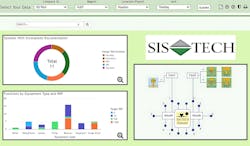When it comes to digital transformation, refining and process operators face unique challenges. Unlike other industries already leveraging digital twins to improve design, enable predictive maintenance, and boost operational efficiency, the refining and process sectors often struggle with data management.
Many facilities have accumulated vast quantities of data over decades, some dating back more than 50 years. This information is often scattered across departments, locked in outdated formats, and managed by tools from different generations. Unfortunately, inconsistent, incomplete, incorrect and unclear data contribute to operator and maintenance mistakes. When they aren’t sure what’s right, confirmation bias can lead to poor decisions. In addition, data fragmentation makes digital transformation more complex because updating one document can render others outdated, creating uncertainty about which version is accurate.
“Everyone is looking to digitalization, but in refining, it’s not that simple,” says Nagappan Muthiah, PE, CFSE, safety instrumented systems (SIS) lead for industrial control systems at Phillips 66.
This complexity occurs because refining has long history of siloing data in different file formats with local storage. Plus, true digitalization is more than uploading files to a centralized platform. It allows data to be shared in real-time with all stakeholders to support effective decision-making.
Consequently, Muthiah and his team at Phillips 66 were recently tasked with digitally transforming its SISs. Their mission was to eliminate data silos, deliver enterprise-wide visibility, clarify to safety lifecycle management, and consolidate decades of dispersed and inconsistent safety data into a smarter, more practical system.
Digitalizing refining needs ROI
Headquartered in Houston, Phillips 66 operates nine refineries, and initially set out to pursue full lifecycle digitalization, when it began its digital journey more than five years ago. Lifecycle digitalization traces safety information from the cradle of the hazard registry to the grave of decommissioning. This would allow Phillips 66 to digitally replicate its safety system from front-end design through to commissioning. In theory, the process would deliver enormous savings in time and money by designing one unit, pressing a button, and reproducing it at other sites (Figure 1).
“It was intellectually satisfying to conceptualize digitalizing the entire process, including front-end design, operation and maintenance,” adds Muthiah. “However, we quickly realized the return on investment (ROI) wasn’t there.” This is because the true opportunity wasn’t in digitalizing front-end design data, but in focusing on the operations, maintenance and safety performance data of existing assets.
ROI is also difficult to track. While it’s obvious that giving staff useful, trustworthy, safety-critical details is worthwhile, it isn't easy to quantify without identifying vulnerabilities and correlating them with historical losses. Investigating why safety layers were triggered is vital to understanding the bottom-line costs of mis-operations. For example, an event with no damage can still result in costly business interruptions. ROI also comes from reducing the risk of spurious trips and losses, identifying vulnerabilities in designs, and reducing over-work by settling on common, standard designs. These include production’s technology, architecture and requirements, and modifying them to align with business objectives.
Consequently, Muthiah and his colleagues decided to reorient their digitalization around SIS during operations and maintenance (O&M), where proactive decisions impact reliability, uptime and safety. This approach aligns with guidance from the American Petroleum Institute’s (API) Recommended Practice 754 that classifies safety metrics into four tiers. While Tier 1 and Tier 2 reflect incidents that already occurred, Tier 3 metrics act as leading indicators—revealing if a safety protection system was activated to prevent a potential event.
From documentation to real-time decisions
Phillips 66 adopted SIS-Tech’s SIL Solver Enterprise+ (SSE+), Version 2.6, functional safety lifecycle tool almost two years ago for its instrumented safeguards, such as alarms, BPCS protection layers, burner management, rotating equipment protection, SIS, high-integrity protection, fire and gas, and equipment protection systems.
Originally created to calculate probability of failure on demand (PFD) and spurious trip rates (STR), SSE+ has evolved into an integrated, safety-management platform. It supports the SIS process from design and documentation to compliance and governance, enabling digital transformation, eliminating data silos, and providing visibility across enterprises. SSE+ also moved onto a web-server, browser-based platform to expand beyond safety management calculations. This lets it provide clause-by-clause analyses, showing compliance with IEC 61511, ISA 8491.03 and ISA84.91.01’s management system requirements.
“Before we started using SSE+, our safety data lived in siloed, digital formats,” explains Muthiah. “You could read it, but tracking, comparing or integrating this safety design basis was much harder.”
SSE+ makes new data visible in forms, tables and graphics appropriate for each target stakeholder in a standard data format. This information is aggregated to generate specifications, I/O lists and maintenance procedures based on the latest data. Every authorized user can access their print tables, forms and documents from one reporting interface. For key metrics, SSE+ uses metadata to control data entry, which lets users see how many functions are classified as BPCS protection layers, SIS, fire and gas, etc.
SSE+ makes comparisons and data integration easier by eliminating barriers to up-to-date process safety information, including the hazard registry, functional requirements, design configuration, performance verification and maintenance procedures. It has four levels of data security for access and editing, and improves work efficiency and reduces errors by flagging missing information on the system list. Data can be changed in one place, and it’s updated in real-time on all stakeholder screens and documents as soon as it’s entered. It also supports concurrent users, so multiple stakeholders can access information simultaneously, and make necessary adjustments much sooner than they could before using Excel spreadsheets on other documents in multiple places.
Beyond making device changes immediately visible to all users, SSE+ can also update related documents more quickly than traditional methods. While updating four or five documents about instruments, interlocks, fire and gas systems, or equipment and environmental protection can typically take an hour or more, SSE+'s access to content enables it to make similar updates in just a couple of minutes.
To contribute to lifecycle digitalization, SSE+ also traces safety design, engineering, operation and maintenance procedures to specified loss events. When users evaluate changes to existing systems, they can easily access, review and update needed information. This shortens the time needed to update documentation, and makes executing functional safety assessments easier. SSE+ also supports comparing corporate, regional and site data, allowing optimization of safety system investments and reducing maintenance costs.
Get your subscription to Control's tri-weekly newsletter.
Centralized data reveals patterns
The secure, cloud-based architecture of SSE+ lets Phillips 66 centralize all SIS data from its refining assets. Rather than managing static reports in disconnected systems, the company’s teams now work in a dynamic environment, where safety data can be filtered, analyzed and compared across units and facilities. Updates made in one area are automatically reflected across all related documentation, ensuring accuracy and alignment from field operations to corporate safety audits.
With its SIS data structured and centralized, Muthiah reports that Phillips 66 is uncovering other patterns that were previously hidden. “It was a paradigm shift—going from exchanging documents to exchanging data,” says Muthiah. “Suddenly, we could slice, dice and act on our safety insights.”
Users can also optimize design and maintenance by comparing how similar equipment hazards are addressed at other sites. For example, SSE+’s dashboards compare safety integrity level (SIL) ratings, function architectures, device technologies or test intervals across systems, sites, regions or organizations (Figure 2). Likewise, it lets Phillips 66 compare SIL ratings across similar systems, standardize processes, and ask deeper operational questions, such as why does one refinery require more SIL 2 functions than another? Is the risk profile accurate or are assumptions misaligned? What about this outlier data?
Facing risks aids performance
Phillips 66 reports that ongoing efforts to access, analyze and visualize SIS data in aggregate are helping it become increasingly proactive in its safety management. As this work progresses, its teams are beginning to identify systemic issues and risk clusters, moving beyond merely addressing isolated failures.
“When you zoom out and leverage relevant data, you move beyond addressing isolated issues and start resolving root causes within the entire system,” adds Muthiah.
Phillips 66’s SIS digital transformation aligns with the Industry 4.0 Maturity Index developed by the National Academy of Science and Engineering (en.acatech.de) in Germany. Its framework outlines six stages of digital maturity:
- Computerization—digitization of analog systems
- Connectivity—systems and data connected across departments, enabling communication
- Visibility—real-time insights into what’s happening
- Transparency—root-cause analysis that explains why things are happening.
- Predictability—anticipating outcomes of future issues or performance
- Adaptability—autonomous response to changing conditions
After several years of focused effort—and with the right tools in place—Phillips 66 sees itself firmly in Stage 2 and advancing toward Stage 3. At that level, SSE+ will enable comparison of evergreen, static safety design data, which reflects how systems should operate, with real-time operational data from the field, to generate Tier 3 metrics aligned with API-752. The next step, Stage 4, is where Muthiah believes more efficiencies will emerge.
“We believe Stage 4 will be a sweet spot, where digitally mapped data helps us make decisions, not just based on theoretical analysis, but on real-world analytics that further improve our safety and reliability,” adds Muthiah.
Digitalizing safety = excellence
Future goals for Phillips 66 include extending insights from SIS into equipment protection systems (EPS), where greater digital transparency can enhance safety and plant efficiency. As operational data continues to mature, the company expects to make even more impactful, real-time decisions.
“The next step would be to expand applications to include asset protection and production loss,” concludes Muthiah. “If a piece of equipment is tripping, there’s a safety aspect, but also a commercial one. If your unit is down, you’re not making money. By looking at the metrics, we expect to improve uptime.”
Rather than attempting a sweeping overhaul, Phillips 66 took a targeted, outcome-driven approach to digital transformation. In doing so, the company transitioned from fragmented, document-heavy, SIS management to a streamlined, data-centric platform. The results were greater efficiency, compliance validation and enterprise-wide visibility. Its journey offers a practical model for how legacy-heavy industries can evolve with clarity, purpose, and measurable impact.
“We’re not digitalizing for its own sake,” explains Muthiah. “We’re focused on what improves safety and reliability.”
About the Author
Angela Summers
SIS-Tech
Angela Summers is president of SIS-Tech and a member of Control’s Process Automation Hall of Fame. She’s a licensed professional engineer with more than 30 years of experience in SIS and contributes to standards from ISA, IEC and others. She can be reached at 713-909-2100, [email protected], or via sis-tech.com.



